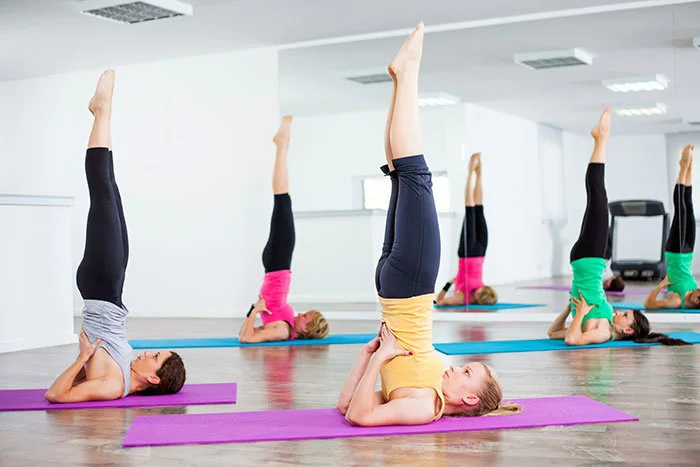- Downward-facing dog (Adho Mukha Svanasana): This asana helps to improve circulation and blood flow to the brain, which can aid in memory retention. It also stretches the hamstrings and shoulders, reducing tension and stress.
- Warrior II (Virabhadrasana II): This pose strengthens the legs and core, promoting stability and balance in both body and mind. It also opens up the chest, encouraging deep breathing that can alleviate anxiety.
- Tree pose (Vrksasana): By focusing on a single point of balance while standing on one leg, this asana improves concentration and coordination. It also stretches the hips and thighs, areas where we tend to store emotional tension.
- Child’s pose (Balasana): This gentle forward bend calms the nervous system by slowing down the breath and heart rate. It provides a restful pause during yoga practice that allows us to recharge mentally as well as physically.
- Corpse pose (Savasana): Often considered the most important part of any yoga practice, Savasana is a relaxation pose that lets us fully release any residual tension or thoughts from our minds. By learning how to fully let go during this final resting posture, we can carry that sense of peace with us off the mat into our daily lives.
What are yogasanas?
Yogasanas are physical postures that originated in ancient India and are a key aspect of traditional yoga practice. These asanas or postures are designed to help the body and mind achieve balance, flexibility, and strength. They are also believed to have therapeutic benefits for various conditions such as stress, anxiety, and depression.
Some examples of yoga asanas that can help improve memory include the Vrikshasana (tree pose) which helps increase focus and concentration by calming the mind. The Padmasana (lotus pose) enhances blood circulation to the brain thus providing more oxygen to enhance memory retention. The Sarvangasana (shoulder stand) involves an inversion posture that encourages increased blood flow to the brain while also stimulating thyroid activity.
Incorporating these yogasanas into your daily routine can be beneficial in improving memory retention among other health benefits such as reducing stress levels and improving overall well-being. It is recommended that one consults with a qualified yoga instructor before incorporating any new poses into their routine especially if they have underlying medical conditions or injuries.
A Brief History of Yogasanas: origins and modern usage
wellhealthorganic.com: yogasanas-to-improve-memory, Yogasanas have a rich and ancient history that dates back to over 5,000 years ago in India. The practice was originally developed as a way to prepare the body for meditation and spiritual practices. Yogasanas were initially passed down through oral tradition from teacher to student. However, the first written record of yoga asanas is found in the Yoga Sutras of Patanjali.
In modern times, yoga asanas have gained immense popularity for their physical and mental health benefits. In addition to improving flexibility, strength, balance, and posture, practicing yoga can also help reduce stress and anxiety levels. Yogasanas are now widely used as a form of alternative therapy by healthcare practitioners around the world due to their healing properties.
Today there are many different types of yoga styles being practiced such as Hatha Yoga, Vinyasa Yoga, Ashtanga Yoga etc. which incorporate various forms of yogasanas into their practice routines which cater towards different goals such as weight loss or stress relief among others.
Some Potential Benefits of Yogasanas for Memory: improved cognitive function, better focus, reduced stress, and more.
Yogasanas, or yoga postures, can help to improve memory and cognitive function. Through regular practice of yoga asanas, individuals can increase blood flow to the brain, which can lead to improved focus and concentration. Additionally, yoga asanas have been shown to reduce stress levels, which is important because stress has been linked to decreased memory function.
Incorporating yogasanas into a daily routine can also provide mental clarity and relaxation. The controlled breathing techniques used in yoga can help calm the mind and reduce distractions that may interfere with memory retention. Furthermore, certain yogic practices that involve visualization and meditation may assist in enhancing memory recall.
Overall, there are numerous benefits of practicing yoga asanas for memory improvement. Whether you’re looking for better cognitive function or more focus during your workday, incorporating a few simple yoga postures into your daily routine could be an effective way to achieve these goals while promoting a healthy lifestyle.
How to do a Yogasana: guidelines for beginners.
Yogasanas are a practice that originated in ancient India and have been popularized all over the world. The benefits of this practice are numerous, from improved flexibility to better mental health. However, for beginners, getting started can be daunting. Here are some guidelines to follow if you’re new to the practice:
- Start small: It’s important not to push yourself too hard when starting out with yoga asanas. Begin with basic poses and gradually work your way up.
- Focus on breathing: One of the core tenets of yoga is deep breathing – this helps you relax and stay focused during your practice.
- Seek guidance: If possible, it’s best to find an experienced instructor who can guide you through each pose and ensure that you’re doing everything correctly.
By following these simple guidelines, anyone can begin their journey towards a healthier mind and body through yoga asanas.
The Best Yogasanas for Memory: Pavanmuktasana, Uddiyana Bandha, Anjaneyasana, Ardha Chandrasana.
Pavanmuktasana, also known as Wind-Relieving Pose, is an effective yoga pose for improving memory. It improves digestion, and relieves stress and anxiety, which are common causes of poor memory. To perform this pose, lie flat on your back and bring your knees towards your chest while holding them with both hands.
Uddiyana Bandha or Abdominal Lock is another yoga asana that can boost memory power. It stimulates the abdominal organs, promotes blood flow to the brain, and enhances concentration levels. To perform this pose stand straight with your feet apart and inhale deeply. Exhale all the air out of your lungs and pull your stomach upwards towards your spine as much as possible.

Anjaneyasana or Low Lunge Pose stretches the hip flexors, hamstrings, and quadriceps while also increasing blood flow throughout the body including to the brain thereby enhancing cognitive function. It is performed by stepping one foot forward into a lunge position while keeping the other leg extended behind you.
How to Practice Yoga Daily for best results: tips for staying motivated.
- Consistency is the key to success when it comes to practicing yoga daily. One way to stay motivated is by setting achievable goals for yourself and making a commitment to stick with them. Start small, such as committing to 10 minutes of yoga every morning, and gradually increase your practice time as you become more comfortable.
- Another effective method for staying motivated in your yoga practice is by finding a community or support system that shares your passion for wellness and mindfulness. Joining a local yoga studio or online group can provide encouragement, accountability, and inspiration.
- Lastly, remember that practicing yoga daily should be enjoyable and fulfilling rather than feeling like a chore or obligation. Mix up your routine with different styles of yoga, try new poses or sequences, listen to music or guided meditations during your practice, and most importantly, have fun!
Take Home Message: If you want to improve your memory, start with yoga!
Yoga is a practice that has been around for thousands of years and has been known to have numerous health benefits. One such benefit is improving memory. Practicing yoga regularly can help improve overall brain function and cognitive ability, leading to better recall and retention of information.
Yogasanas or yoga postures that specifically target the brain, such as the Padmasana (lotus pose) and the Vajrasana (diamond pose), can enhance mental clarity, focus, and concentration. These poses work by increasing blood flow to the brain while calming the mind, which in turn helps reduce stress levels that can negatively impact memory.
In addition to specific poses, meditation, and pranayama (breathing exercises) are also integral parts of yoga that aid in improving memory. Focusing on deep breathing techniques helps calm the mind and improves oxygen flow to the brain, which enhances cognitive function. Overall, incorporating yoga into your daily routine is an effective way to enhance your overall well-being by boosting your physical health while also sharpening your mental faculties.
What are Yogasanas and how do they improve memory?
Yogasanas are a set of postures and breathing exercises that originated in ancient India. These exercises are designed to improve physical health, mental clarity, and emotional well-being. When practiced regularly, yoga asanas can help individuals enhance their memory power.
Yogasanas have been found to increase blood flow to the brain, which can boost cognitive function and memory retention. The deep breathing techniques used in yogic practices also help relax the mind and reduce stress levels. This reduction in stress levels is particularly helpful for individuals who struggle with anxiety or depression-related memory loss.
Furthermore, certain yoga asanas like the Padmasana (lotus pose) and Sirsana (headstand) require focused concentration that helps improve concentration levels over time. Practicing these asanas regularly along with meditation can lead to better focus, enhanced cognitive abilities, and ultimately improved memory power. Overall, incorporating regular yoga practice into your daily routine can do wonders for your mental health along with building strong memories at all ages.
Types of Yogasanas: There are many different types of yoga asanas and each one has benefits for improving memory.
One type of yoga asana that can improve memory is the Padmasana or Lotus Pose. This pose helps to calm the mind and reduce stress, which in turn can improve cognitive function. It also improves blood circulation to the brain, providing it with more oxygen and nutrients.
Another effective yoga asana for improving memory is the Sarvangasana or Shoulderstand Pose. This pose requires you to invert your body, allowing for increased blood flow to the head and neck. It also stretches and strengthens the neck muscles, which can help relieve tension headaches and promote relaxation.
Finally, practicing Vajrasana or Thunderbolt Pose has been shown to enhance brain function by increasing blood flow and reducing stress levels. It involves sitting on your knees with your heels touching your buttocks and keeping your spine straight while breathing deeply. By regularly practicing these yogasanas along with a healthy lifestyle, individuals can potentially experience improved memory retention and recall abilities.
How Yogasanas Improve Memory: The research is clear – yogasanas help improve long-term memory.
One of the primary benefits of practicing yoga asanas is improved memory. It has been scientifically proven that the practice of certain yoga asanas can help improve long-term memory. This is because yoga involves physical movement, deep breathing, and meditation, which all work together to enhance cognitive function.
Some specific yoga asanas that are known to boost memory include Paschimottanasana (Seated Forward Bend), Sarvangasana (Shoulder Stand), and Bhramari Pranayama (Bee Breath). These poses increase blood circulation to the brain and stimulate the nervous system, leading to improved cognitive function.
Furthermore, regular practice of yoga has been shown to reduce stress levels and promote relaxation, which are also crucial factors in improving memory retention. By reducing stress and increasing focus through mindfulness practices like yoga, individuals can improve their ability to remember things over time. Overall, it’s clear that incorporating yoga asanas into your daily routine can lead to significant improvements in both physical health and mental cognition.
How to Do Yogasanas for Better Memory: There are a few easy steps you can follow to improve your memory with yoga.
Yoga is a practice that has been around for thousands of years and is known to have numerous benefits. One of the lesser-known benefits of yoga is its ability to improve memory. Yogasanas, or yoga postures, can help improve blood flow to the brain and reduce stress levels, both of which are important factors in improving memory.
To start, try practicing pranayama, or deep breathing exercises. This helps to calm the mind and reduce stress levels. Next, incorporate specific yoga asanas that focus on increasing blood flow to the brain such as the Shoulderstand pose (Sarvangasana) or Downward Facing Dog pose (Adho Mukha Svanasana). Finally, end your yoga session with meditation, focusing on positive affirmations related to memory improvement.
Incorporating these simple steps into your daily routine can help improve your memory over time. With regular practice and dedication, you may find yourself more focused and alert than ever before.
Conclusion:
Yogasanas are a great way to improve your memory and overall health.
yoga asanas are an excellent way to enhance your memory and overall health. These physical postures help to increase blood flow and oxygenation in the brain, which is vital for cognitive function. Practicing yoga regularly can also reduce stress levels and improve sleep quality, both of which are essential for optimal brain function.
Moreover, many yoga asanas specifically target the hippocampus, a region of the brain that plays a crucial role in memory formation and retention. As such, incorporating these poses into your daily routine can help you remember information better and more quickly recall memories.
In addition to improving memory, yoga has numerous other benefits for overall health. It helps to alleviate anxiety and depression symptoms as well as improve flexibility and balance. With so many advantages, it’s no wonder that yoga asanas have become increasingly popular among people of all ages looking to optimize their physical and mental well-being.
Read Also… wellhealthorganic-com-11-health-benefits-and-side-effects-of-olives-benefits-of-olives









